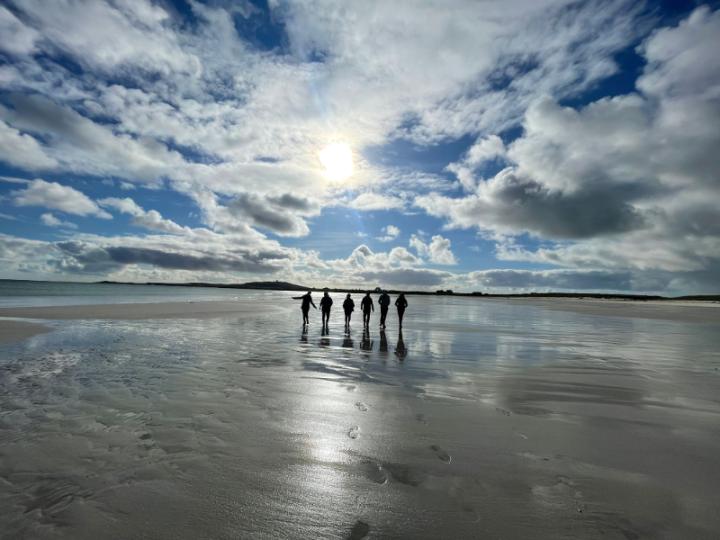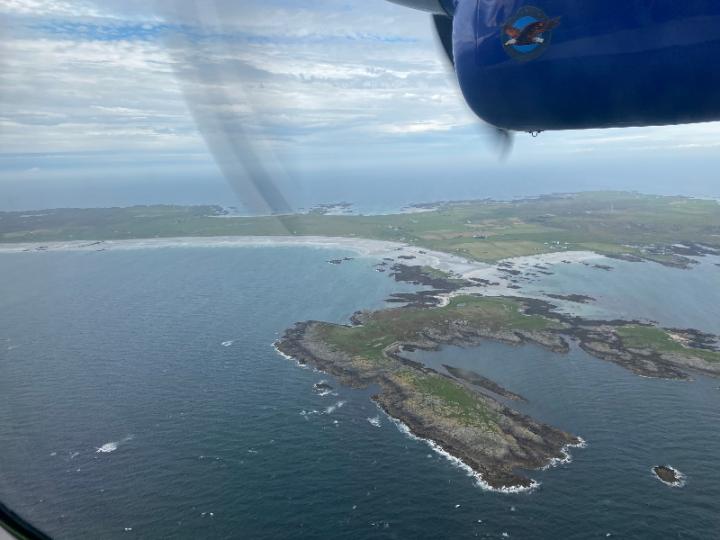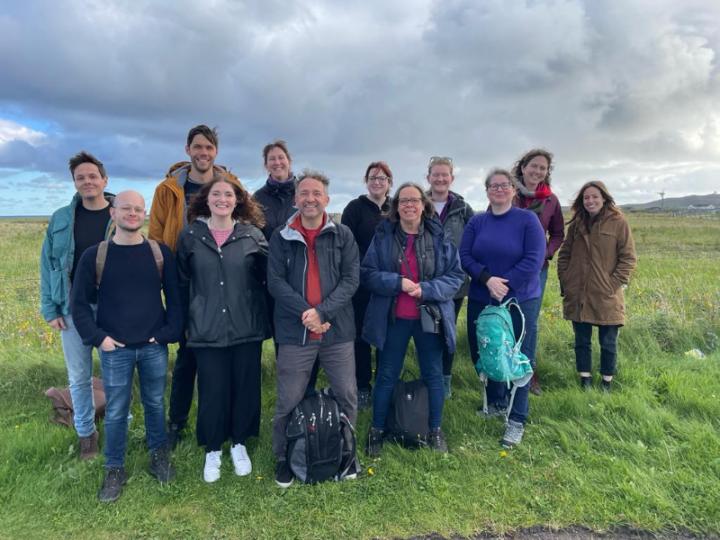Careful Waves
Andrea Ford recounts her time at the Tiree Tech Wave in western Scotland

It’s not often you get invited to spend a week on a remote island for work. Or at least, this was the first time it happened to me! I was immediately intrigued, my taste for adventure and the unorthodox activated.
The Tiree Tech Wave was started on the tiny Hebridean island of Tiree off the west coast of Scotland in 2011. It is an unlikely place for technology development to happen, and that is precisely the point. Alan Dix, a scholar who works “on most things that connect people and computers” and former Tiree resident, founded it to consider ‘technology at the margins,’ both geographical and social. The fact that it has continued roughly-annually and usually-in-Tiree for the past decade or so speaks to its loose agenda. It is what you make of it.
Upon investigating, I realized I had heard of this event before, from a speaker at the University of Chicago Media Arts, Data, and Design Center while I was completing my PhD. He told us about experimental ways to use wind energy and showed photos of maker-shop gadgets amidst groups of people who looked like adults out playing. The Tech Wave has an international reach, yet is quite unlike other international academic conferences.
In September this year, I boarded a tiny plane with a dozen or so other people, and we gathered at a historic Tiree bunkhouse a stone’s throw from the Atlantic. A handful of us began each morning with a very chilly swim. One day, a seal popped his puppy-dog head up a few metres away, investigating. I found it oddly easy to slip into a new routine, having been so thoroughly de-contextualised. And that was the point – to take academics out of their normal deadlines and timetables, and instead “have the freedom to explore ideas together and pick up some of the clarity of mind fostered by the wild environment and appreciated by the monastic traditions of study at the western fringe.” It offered the opportunity to be with other creative intellectual folks in a very different and unstructured way, allowing new connections to flow.
This particular Tiree Tech Wave was organized around the intersection of rurality, care, and ageing. Lucy McCloughan, Cara Wilson, and Arlene Casey, respectively affiliated with the Advanced Care Research Centre (ACRC), Institute for Design Informatics, and Usher Institute at the University of Edinburgh, organised the trip with the support of the Wellcome Trust’s Institutional Strategic Support Fund (ISSF). We gathered to explore what kinds of care technology might facilitate (or hinder), but moreover to check our urban, cosmopolitan assumptions about what technology might be or do, and who it might be for. It’s unusual for a Tech Wave to feature people largely from the same institution, but most of us didn’t know the others beforehand, and we came from a swath of different backgrounds.

Unlike many there who were already involved with technology and design, I felt as though I approached the whole project rather upside-down. For me, a cultural anthropologist, it wasn’t the effort to consider various perspectives and contexts that was novel. It was technology development itself, and applying qualitative insights to practical projects. Ethnography, the method in which I was trained, is a long slow process of trying to put yourself in someone else’s shoes. The social sciences and artistic traditions often ask how we can change our understanding or find a good question. They are less predetermined than ‘hard’ sciences and industry where technologies are usually developed.
Participatory design is a kind of middle ground. Also known as co-design, it aims to involve people in research and design technologies with them, not for them. When done well, it’s integral to the very inception of a project, not tagged on as an afterthought, and not tokenistic or reductionistic. It requires stepping away from ‘technosolutionism,’ the mindset that a novel technology can be inserted by experts to solve any problem. Rather, it requires an exploratory and humble mindset, seeking to understand not just the current context but the desired future of the people who might use the technology. (In learning about co-design, I never heard history mentioned! The focus was always on the future, but there is a lot that a historical perspective could contribute).
There are intentionally no intentional outcomes for a Tech Wave – but I’ll share a few glimpses into how we spent time. For me, the memorable moments seemed to cohere around storytelling.
Rachel Gwilym sat in the bunkhouse lounge, her three homeschooled daughters alongside, all of us leaning in towards her tale about the Hunchback and the Swan. An island resident who offers informal grief counseling and is interested in facilitating natural burial practices, she uses storytelling to help people talk about care in a more indirect way, as it can be a delicate, sad subject. Which character in the story did we identify with? she asks.
A scholar from Durham, Andy Darby paced around the room as he spoke about speculative design fiction and led us all in our own dystopian technology storytelling. ‘Push the metaphor as far as you can,’ he says, ‘that’s how it gets provocative.’ Listening to Andy talk was like watching a series of pitches for Black Mirror episodes. From compulsory cochlear implants to a euthanasia wearable, he showed us a method for thinking about what technology is preferable, and to whom, rather than just elaborating what technology is possible, plausible, and probable, a narrowing cone pointing to the future.
Tiree digital artist and animator, Rou, has been attending Tech Waves for years and shared a children’s book created with the help of the local primary school, with text in English and Gaelic. It chronicles two warring queen bees, one of whom is a species now found only in some Scottish islands, and how the crofter and farmer adapt their practices to help the struggling bee.

Most memorable was when we all piled into a spare white church, gleaming and spacious and empty except for two tables with members of the Cùram Thiriodh group seated around them. The group was composed of elderly Tiree residents, and we had gathered to make a zine with them. Zines are activist pamphlets that had their heyday in 1980s and 1990s feminism, and Kiersten Hay energetically led us in this form of group storytelling. Tiree is the most intact crofting community in Scotland, meaning it is arranged in small holdings with some shared land usage rights, and everyone is very spread out. There are no concentrated towns or built-up areas. Care is largely organised around family, friends, and peer networks like Cùram, which have enormous value that is unaccounted for in formal and academic reckonings of care provision. Yet the network was fragile; four of the people who delivered meals on wheels with Cùram were octogenarians themselves! The retired optometrist who was one of the leaders kept saying ‘we were fearful’ about the care home being closed, about the state of the building and the lack of funding, about the rising housing costs as 40% of the island’s buildings became vacation homes for outsiders.
There were long walks and morning swims, getting up-close with cattle, sharing coffee in pyjamas. It was a peaceful jolt, but a jolt nonetheless, out of one’s ordinary. Chunks of the day were spent companionably, independently typing away on laptops as we sat around the common room. A group writing retreat of sorts, a fallow season (and still too brief of one, at that) required for any sustainable productivity, as we are cyclical beings, not regularly humming machines. Building ‘rest’ into a scholarly program is almost unthinkable for such driven, disciplined, ‘productive’ people as make it into the upper echelons of scholarship. But we need these spaces, they are essential to us and to making academia more accessible to others.
The place where a co-design ethos really shone through was in breaking us out of disciplinary silos. It’s very easy to get caught up in your methods and your academic community, preaching to the choir as it were. Being thrown into an unusual scenario without an agenda was a great way to learn from each other, bypassing the high-stakes feeling and defensive attitude that can sometimes accompany formal interdisciplinary work.
It created a very different kind of sociality, a different fertility for collaboration. What can grow is to some degree a function of the soil. Indeed, many gardeners would assert that soil is the most essential thing.

